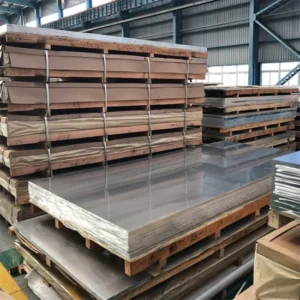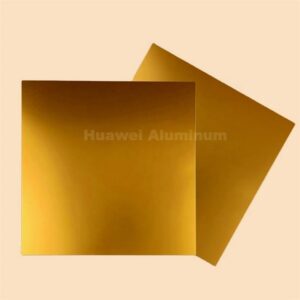







3003 Aluminium Sheet Plate
Explore the complete guide to 3003 aluminum sheet plate. Discover its mechanical properties, common uses, fabrication tips, and why it’s the industry’s workhorse.
In the vast landscape of non-ferrous metals, 3003 aluminum sheet plate holds a unique and enduring position.
It is not the strongest, nor the most corrosion-resistant, yet it is arguably the most important commercial aluminum alloy.
Often referred to as the “workhorse” of the industry, its widespread adoption is a testament to an exceptionally well-balanced profile of properties that deliver reliability, versatility, and economic value.
This guide moves beyond surface-level data to provide you with the deep, practical insights gained from decades of industry experience.
We will explore not just what 3003 Aluminium est, sed why it behaves the way it does and how to leverage its characteristics for optimal results in your applications.

The Foundational Identity of 3003 aluminium
3003 aluminum belongs to the 3xxx series, which features manganese (Mn) Sicut primaria offering elementum.
Ad eius core, it is commercially pure aluminum (from the 1xxx series) fortified with a nominal addition of 1.2% manganese. This seemingly minor addition is transformative.
The manganese atoms integrate into the aluminum crystal lattice, a mechanism known as solid solution strengthening.
This integration disrupts the uniform atomic planes, making it more difficult for them to slip past one another under stress.
The result is a material that is approximately 20% stronger than 1100 (commercially pure) aluminium, without a significant penalty to its excellent formability or corrosion resistance.
Crucially, 3003 aluminum sheet plate is a non-heat-treatable alloy.
Its strength cannot be enhanced by heating and quenching cycles.
Pro, cold working processes like rolling increase its hardness and strength—a method known as strain hardening, indicated by ‘H’ tempers.
Defining Characteristics of 3003 aluminium
Several key, reliable characteristics form the foundation of 3003 aluminum sheet plate’s popularity
1. Exceptional Formability and Workability
This is the hallmark of 3003 aluminium.
It can be readily bent, impressit, drawn, spun, and roll-formed, accommodating intricate designs with minimal risk of fracture.
- What this means for you:
This attribute translates to lower tooling costs, reduced scrap rates, and greater design freedom for complex parts like deep-drawn cookware, intricate architectural panels, or tightly bent ductwork.
Its forgiving nature makes it a favorite among fabricators.

2. Very Good Corrosion Resistance
3003 aluminium sheet offers excellent resistance to general atmospheric corrosion.
It also holds up well against many foods, potiones, and mild industrial chemicals.
- What this means for you:
You can confidently specify 3003 for long-lasting applications like roofing, sididus, and gutters, as well as for food-grade equipment, without the need for expensive protective coatings in many environments.
3. Excellent Weldability
This alloy is easily welded using conventional TIG (GTAW) et mihi (Gawn) processes, producing strong and sound joints.
- What this means for you:
Fabrication of complex assemblies is straightforward. The ease of welding simplifies repairs and reduces manufacturing complexity, contributing to lower production costs.
4. Moderate and Reliable Strength
While not a “summus vires” material, its strength is predictable and more than sufficient for a vast array of non-structural and light structural applications.
- What this means for you:
It provides a significant performance upgrade over 1100 aluminum for applications requiring greater rigidity and durability, such as equipment enclosures, tanks, and chemical equipment.
Technical Specifications: The Data Behind the Performance
A professional understanding requires a look at the precise data that governs the material’s behavior.
Chemical compositionem (ASTM B209)
The tight control of elemental composition is key to 3003’s consistent performance.
| Elementum | Contentus (%) | The Role and Impact on 3003 aluminium |
|---|---|---|
| Manganese (Mn) | 1.0 – 1.5 | Primary Alloying Element. The key driver of strength through solid solution. |
| Aes (Cu) | 0.05 – 0.20 | Provides a minor but helpful boost to strength. |
| Pii (And) | ≤ 0.6 | An impurity. Controlled to ensure consistent mechanical properties. |
| Ferrum (Fe) | ≤ 0.7 | An impurity. Higher levels can slightly reduce ductility and corrosion resistance. |
| Zinc (Zn) | ≤ 0.10 | An impurity controlled to low levels. |
| aluminium (Al) | Statera | The base metal, providing the fundamental lightweight and corrosion-resistant nature. |
Mechanical Properties by Temper
Mechanica proprietatibus 3003 aluminium sheet are a direct function of the amount of cold work applied (ingenium).
| Ingenium | Descriptio | distrahentes Fortitudo (MPa, typical) | cede virtus (MPa, typical) | duritia (Brinell, HBW) |
|---|---|---|---|---|
| O* | Annaeus (Fully Soft) | 110 | 40 | 28 |
| H12 | Strain-Hardened (Quarter Hard) | 125 | 95 | 35 |
| H14 | Strain-Hardened (Half Hard) | 140 | 125 | 40 |
| H16 | Strain-Hardened (Three-Quarters Hard) | 165 | 145 | 47 |
| H18 | Strain-Hardened (Full Hard) | 185 | 165 | 55 |
| H24 | Strain-Hardened & Partially Annealed (Half Hard) | 140 | 105 | 41 |
Understanding H-Tempers: The “H1” series means strain-hardened only. The “H2” series (e.g., H24) means strain-hardened more than desired and then partially annealed (softened) back to the final temper, resulting in slightly lower yield strength but better ductility than its H1 counterpart.
Physica proprietatibus
- Density: 2.73 g/cm³ (0.0986 lb/in³)
- Melting Range: 643 – 654 °C (1190 – 1210 °F)
- Scelerisque Conductivity: ~193 W/m·K (Excellent for heat transfer applications like radiators and heat exchangers)
- Electrical Resistivity: ~3.4 µΩ·cm at 20°C
- Modulus Elasticitatis: 69 GPa (10,000 ksi)
Fabrication and Processing: An Expert Perspective
Successfully working with 3003 aluminum sheet plate involves understanding its nuances.
Forming and Bending
Due to its high ductility, 3003-O* can often be bent to a 0T radius (bent flat upon itself) in thinner gauges.
Harder tempers like 3003-H14 require a larger bend radius (e.g., 1T to 2T) to prevent cracking.
Always consider springback; the material will partially return to its original shape after the bending force is removed, requiring slight over-bending.

Welding
For optimal results, use a 4043 filler rod, which offers good flow and minimizes weld cracking.
An 1100 filler can be used where maximum ductility of the weld itself is required.
Crucially, in Heat Affected Zone (HAZ) next to the weld will lose the strengthening effects of cold work, effectively reverting to the soft ‘O’ ingenium.
This reduction in strength in the HAZ must be accounted for in the design of load-bearing welded assemblies.
Machining
Machining 3003 aluminium requires high speeds, sharp tools, and adequate lubrication.
For softer tempers, tools with high rake and clearance angles are recommended to prevent the “gummy” material from building up on the cutting edge.
Harder tempers produce cleaner chips and a better surface finish.
Superficiem curatio
- Anodizing:
3003 can be readily anodized for enhanced corrosion and wear resistance.
tamen, it is not an “anodizing quality” (AQ) mixtura. The resulting anodic film is durable and protective but will typically have a slightly matte, grayish appearance.
For bright, patet, or vibrant decorative anodizing, an alloy like 5005 is a superior choice. - Chemical Conversion Coating:
This is a common and highly effective treatment for 3003.
Applying a chromate (e.g., Alodine) or non-chrome conversion coating provides excellent corrosion resistance and serves as an exceptional primer for paint and powder coating adhesion. - Painting & Powder Coating:
With proper pre-treatment (cleaning and conversion coating), 3003 provides an excellent substrate for all types of organic coatings.

Communia Applications: Where Performance Meets Value
The well-rounded properties of 3003 aluminum sheet plate make it ubiquitous across industries:
- Aedificatio & Construction: COMPINATIO, sididus, gutters, corrugated sheets, and architectural panels.
- Hvac & Heat Transfer: Heat exchanger fins and tubes, radiator cores, and evaporators.
- Food & Chemical Industry: CREPULCUS, utensils, repono obterere, limbis, and processing equipment.
- General Manufacturing: Stamped brackets, equipment enclosures, fan blades, ductwork, et signage.

Strategic Alloy Comparison
| Pluma | 3003 aluminium | 5052 aluminium | 6061-T6 Aluminum |
|---|---|---|---|
| Primary Strength | Excellent Formability & Valor | High Fatigue Strength & Marine Corrosion Resistance | Princeps viribus ad-pondus ratio (Structural) |
| Fortitudo (Typical) | Moderatus (140 MPa for H14) | Altum (230 MPa for H32) | PERPREPIDUS (310 MPa for T6) |
| Corrosio Resistentia | PERPLICENTER (Atmospheric) | Praeclarus (Especially Saltwater) | bonum (Can be prone to pitting) |
| Weldability | Praeclarus | PERPLICENTER | bonum (Significant strength loss in HAZ) |
| Formability | Praeclarus | bonum | Aequus (Poor in T6 temper) |
| Primary Use Case | General purpose sheet metal & formatio | Marine, chemical tanks, high-vibration parts | Structural frames, machine parts, high-stress apps |
conclusio
3003 aluminum sheet plate is more than just a commodity; it is the backbone of countless industries.
Its unique balance of moderate strength, outstanding formability, bonum corrosione resistentia, and excellent value makes it an incredibly reliable and versatile material.
By understanding its specific characteristics and comparing it to other alloys, you can confidently choose 3003 aluminum for your next project, knowing it delivers proven performance.






